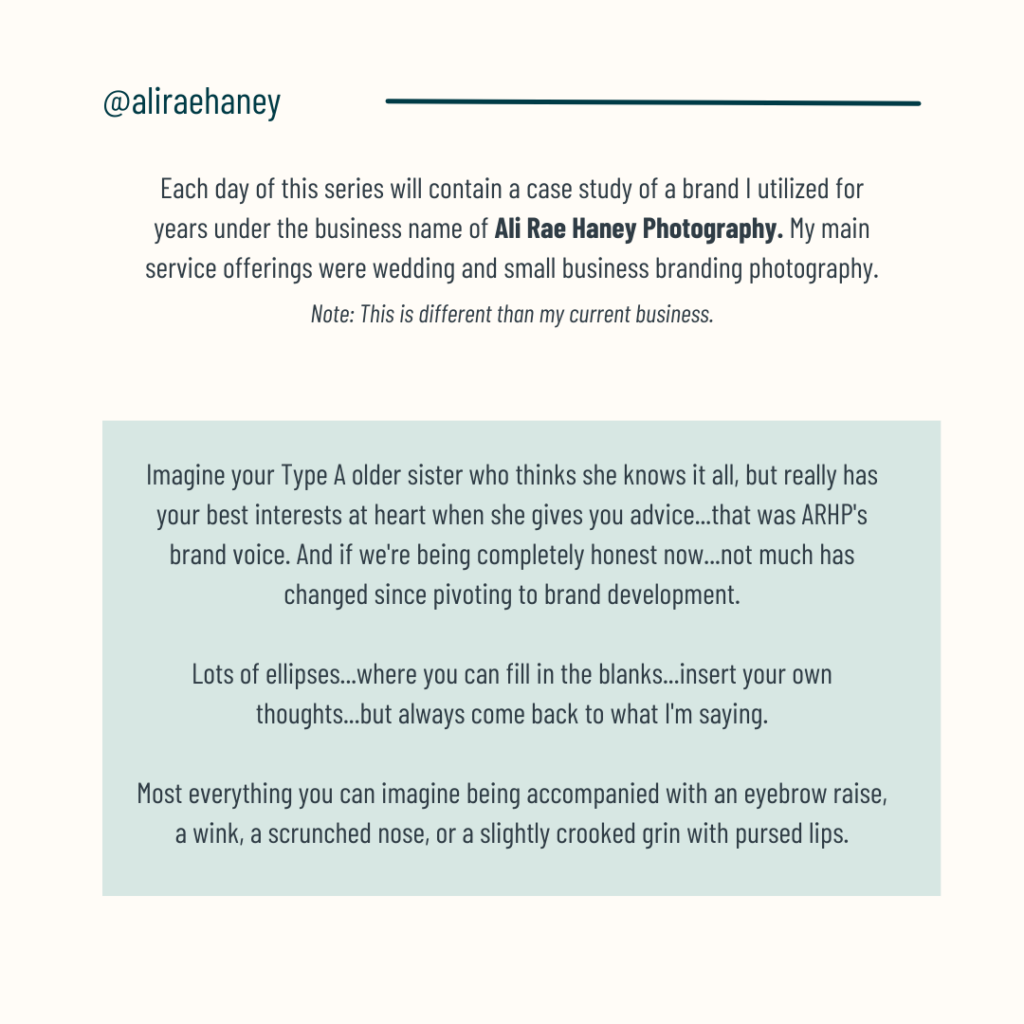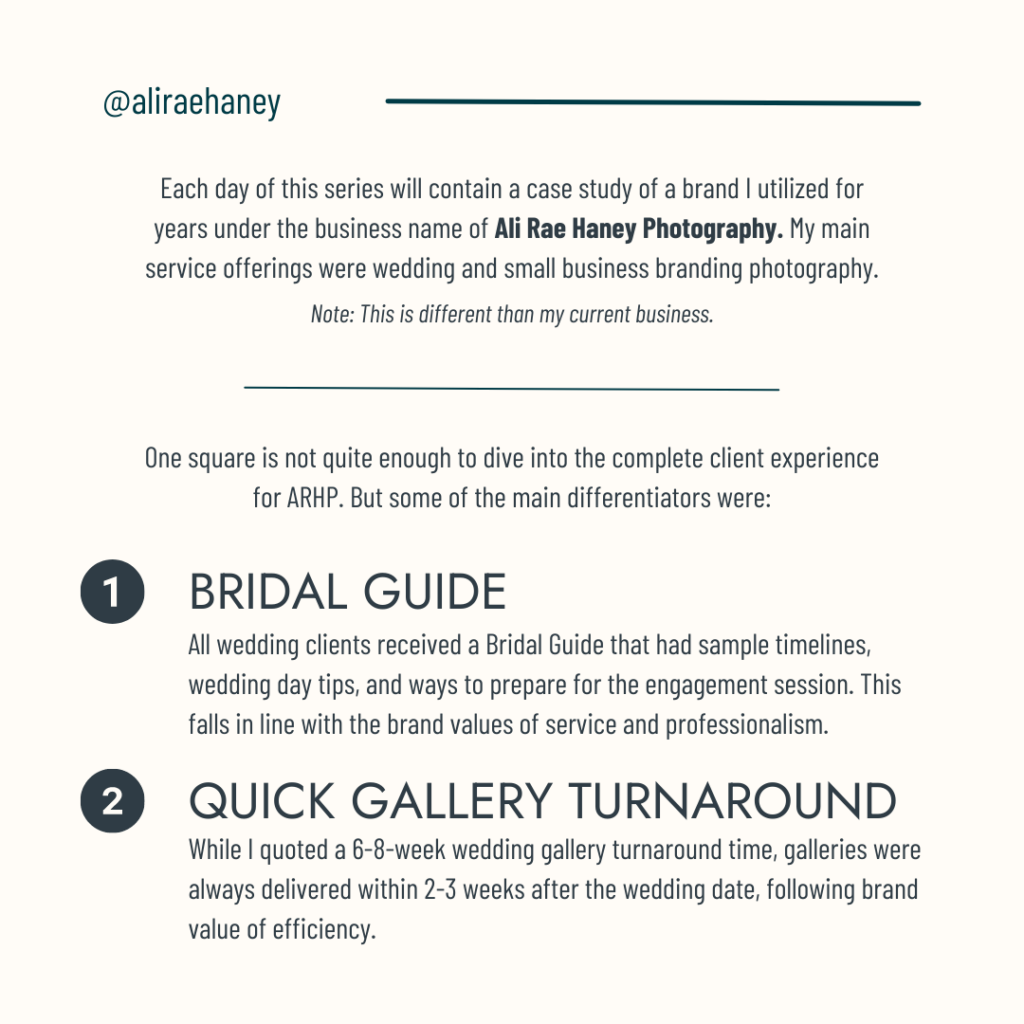VIEW OUR SERVICES
For those looking to build a cohesive and consistent brand presence & grow their business.
type below and hit enter
Search the blog
BUSINESS
MARKETING
BRANDING
Browse by topic
I'm Ali Rae and I love building brands.
So let's build that business one blog post at a time.
Read more about me
FANCY SEEIN' YOU HERE!
PERSONAL
Let's whip that brand into shape!
BRAND AUDIT
CHECKLIST
FREEBIE ALERT
Brand Element Breakdown
August 22, 2023

Recently, I did a Brand Element Series on Instagram with a case study using one of my old brands, Ali Rae Haney Photography. I offered wedding and small business branding services, but for the purpose of this “case study,” we are going to focus on the wedding service offering.
For each brand element, you will see three informational items about the element. Then the explanation of the brand element of Ali Rae Haney Photography. If you’re anything like me, it is super helpful to see not only the definition of each element, but also the application of the element in real life! So here goes!
LOGO
- Always keep your ideal client in mind when creating any part of your brand, but especially in pieces that show up repeatedly.
- The brain recognizes shapes first, then colors, then content/meaning. Keep this in mind when choosing your logo.
- Keep logotype in mind as well. Although it wasn’t specifically touched on in this example, having consistent logotype for different orientations is helpful when designing different pieces of marketing materials.

COLORS & FONTS
- The consistent use of specific colors and fonts helps distinguish your brand from others, making it easily recognizable to your audience.
- Colors and fonts are crucial in depicting your brand’s personality. They can indicate whether your brand is serious, playful, professional, or creative–color theory is so cool and very real!
- Colors and fonts play a key role in evoking emotions and setting the mood. For instance, warmer colors can evoke excitement, while cooler colors can convey calmness. Similarly, bold fonts may signify strength, while script fonts can suggest elegance.

VALUES
- Defined brand values promote consistent messaging and branding across all platforms, providing a unified brand experience for the audience.
- Brands with clear values are more likely to build sustainable relationships with customers, leading to long-term growth and profitability.
- Brand values serve as a compass for strategic decisions, ensuring that actions and initiatives align with the company’s core beliefs.

MISSION STATEMENT
- A clear mission can differentiate a brand from its competitors, highlighting its unique stance and commitments.
- A mission statement helps maintain consistency in branding messages across different platforms, creating a cohesive brand image.
- A brand mission statement provides clarity about a company’s primary purpose and objectives, guiding its actions and decisions.

TAGLINE
- A memorable tagline quickly captures and reinforces a brand’s identity, making it instantly recognizable to the audience.
- A distinctive tagline can set a brand apart in a crowded marketplace, emphasizing its unique offerings or perspective.
- A consistent tagline used across all marketing channels reinforces the brand message, fostering familiarity and trust.

BRAND DESCRIPTORS
- Brand descriptors are specific adjectives or short phrases that capture the essential characteristics, attributes, and values of a brand.
- Brand descriptors provide a framework for consistent messaging across various marketing channels, ensuring the communication is uniform.
- When customers encounter consistent descriptors across various touchpoints, they are more likely to remember the brand and associate it with specific qualities.

BRAND VOICE
- A brand’s voice establishes a unique presence in the market, differentiating it from competitors. Kind of like when your mom used to tell you, “It’s not what you say, it’s how you say it. That’s your brand voice.
- A relatable and authentic brand voice can resonate with audiences, encouraging more meaningful interactions and engagement.
- Understanding the brand’s voice streamlines content creation, ensuring all materials align with the brand’s essence.

BRAND MESSAGING
- Uniform messaging across all platforms solidifies brand identity, leading to a consistent brand experience for consumers.
- Repetitive use of specific vocabulary creates brand awareness and association with keywords.
- Distinctive messaging sets a brand apart in a crowded marketplace, emphasizing its unique offerings and attributes.

UNIQUE VALUE PROPOSITION
- A Unique Value Proposition (UVP) is a concise and clear statement that communicates the distinct benefits, advantages, and value that a product, service, or brand offers to its target audience.
- Knowing your UVP, particularly in a crowded/saturated market, is imperative to make your brand stand out amongst other businesses that offer similar services/products.
- When customers feel that a brand offers a unique and valuable solution, they are more likely to make a purchase and become loyal advocates.

CLIENT EXPERIENCE
- This is where all that branding elements come together in a beautiful crescendo to deliver a knock-out client experience.
- This experience can be in-person or online; regardless, the ease of the interaction has a huge impact on how a client/customer perceives the overall brand.
- A positive client experience fosters loyalty. Satisfied clients/customers are more likely to return for repeat purchases, leading to higher customer retention rates and referrals!

This was a super long blog post, but I truly hope that it was valuable not only to have each brand element defined, but also to see it brought to life by showing you [what was once] a real brand. If you have another brand you want me to try and break down, I would love for you to comment below!
Let's talk business.
@brandandmarket.co
find me on
LET'S WORK TOGETHER
brand & market newsletter
Let's make you the best in your brand and your market.
We turn listings into legacies.
BRANding & COHOSTING
View website terms
View privacy policy
© 2025 ali rae haney productions, llc. all rights reserved. privacy policy. site by Ali Rae Haney + Showit
schedule discovery call
Ready to make your listing into a legacy?